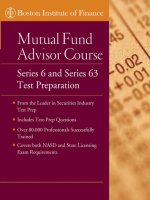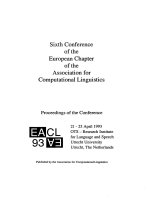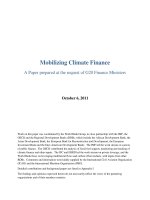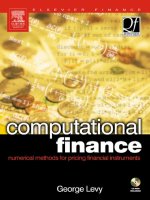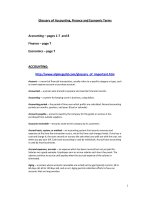COMPUTATIONAL FINANCE pot
Bạn đang xem bản rút gọn của tài liệu. Xem và tải ngay bản đầy đủ của tài liệu tại đây (3.82 MB, 459 trang )
//SYS21///INTEGRAS/ELS/PAGINATION/ELSEVIER UK/CMF/3B2/FINALS_21-11-03/PRELIMS.3D – 1 – [1–14/14]
21.11.2003 2:55PM
COMPUTATIONAL FINANCE
//SYS21///INTEGRAS/ELS/PAGINATION/ELSEVIER UK/CMF/3B2/FINALS_21-11-03/PRELIMS.3D – 2 – [1–14/14]
21.11.2003 2:55PM
//SYS21///INTEGRAS/ELS/PAGINATION/ELSEVIER UK/CMF/3B2/FINALS_21-11-03/PRELIMS.3D – 3 – [1–14/14]
21.11.2003 2:55PM
COMPUTATIONAL FINANCE
Numerical Methods for Pricing Financial Instruments
George Levy
AMSTERDAM BOSTON HEIDELBERG LONDON NEW YORK OXFORD
PARIS SAN DIEGO SAN FRANCISCO SINGAPORE SYDNEY TOKYO
//SYS21///INTEGRAS/ELS/PAGINATION/ELSEVIER UK/CMF/3B2/FINALS_21-11-03/PRELIMS.3D – 4 – [1–14/14]
21.11.2003 2:55PM
Butterworth-Heinemann
Elsevier
Linacre House, Jordan Hill, Oxford OX2 8DP
200 Wheeler Road, Burlington, MA 01803
First published 2004
Copyright
#
2004, George Levy. All rights reserved
The right of George Levy to be identified as the author of this work
has been asserted in accordance with the Copyright, Designs
and Patents Act 1988
No part of this publication may be reproduced in any material form (including
photocopying or storing in any medium by electronic means and whether
or not transiently or incidentally to some other use of this publication) without
the written permission of the copyright holder except in accordance with the
provisions of the Copyright, Designs and Patents Act 1988 or under the terms of
a licence issued by the Copyright Licensing Agency Ltd, 90 Tottenham Court Road,
London, England WIT 4LP. Applications for the copyright holder’s written
permission to reproduce any part of this publication should be addressed
to the publisher.
Permissions may be sought directly from Elsevier’s Science and Technology
Rights Department in Oxford, UK. Phone: (þ44) (0) 1865 843830;
fax: (þ44) (0) 1865 853333; e-mail:
You may also complete your request on-line via the Elsevier homepage
(), by selecting ‘Customer Support’ and then ‘Obtaining
Permissions’
British Library Cataloguing in Publication Data
A catalogue record for this book is available from the British Library
Library of Congress Cataloguing in Publication Data
A catalogue record for this book is available from the Library of Congress
ISBN 0 7506 5722 7
For information on all Elsevier Butterworth-Heinemann publications
visit our website at www.bh.com
Typeset by Integra Software Services Pvt. Ltd, Pondicherry, India
www.integra-india.com
Printed and bound in The Netherlands
//SYS21///INTEGRAS/ELS/PAGINATION/ELSEVIER UK/CMF/3B2/FINALS_21-11-03/PRELIMS.3D – 5 – [1–14/14]
21.11.2003 2:55PM
To Kathryn
//SYS21///INTEGRAS/ELS/PAGINATION/ELSEVIER UK/CMF/3B2/FINALS_21-11-03/PRELIMS.3D – 6 – [1–14/14]
21.11.2003 2:55PM
//SYS21///INTEGRAS/ELS/PAGINATION/ELSEVIER UK/CMF/3B2/FINALS_21-11-03/PRELIMS.3D – 7 – [1–14/14]
21.11.2003 2:55PM
Contents
Preface xi
Part I Using Numerical Software Components within Microsoft Windows 1
1 Introduction 3
2 Dynamic Link Libraries (DLLs) 6
2.1 Visual Basic and Excel VBA 6
2.2 VB.NET 16
2.3 C# 21
3 ActiveX and COM 28
3.1 Introduction 28
3.2 The COM interface IDispatch 30
3.3 Type libraries 31
3.4 Using IDispatch 31
3.5 ActiveX controls and the Internet 33
3.6 Using ActiveX components on a Web page 34
4 A financial derivative pricing example 38
4.1 Interactive user-interface 38
4.2 Language user-interface 38
4.3 Use within Delphi 41
5 ActiveX components and numerical optimization 44
5.1 Ray tracing example 44
5.2 Portfolio allocation example 49
5.3 Numerical optimization within Microsoft Excel 51
6 XML and transformation using XSL 54
6.1 Introduction 54
6.2 XML 55
//SYS21///INTEGRAS/ELS/PAGINATION/ELSEVIER UK/CMF/3B2/FINALS_21-11-03/PRELIMS.3D – 8 – [1–14/14]
21.11.2003 2:55PM
6.3 XML schema 57
6.4 XSL 59
6.5 Stock market data example 60
7 Epilogue 64
7.1 Wrapping C with Cþþ for OO numerics in .NET 64
7.2 Final remarks 73
Part II Pricing Assets 75
8 Introduction 77
8.1 An introduction to options and derivatives 77
8.2 Brownian motion 78
8.3 A Brownian model of asset price movements 81
8.4 Ito’s lemma in one dimension 83
8.5 Ito’s lemma in many dimensions 84
9 Analytic methods and single asset European options 87
9.1 Introduction 87
9.2 Put–call parity 88
9.3 Vanilla options and the Black–Scholes model 90
9.4 Barrier options 110
10 Numeric methods and single asset American options 116
10.1 Introduction 116
10.2 Perpetual options 116
10.3 Approximations for vanilla American options 121
10.4 Lattice methods for vanilla options 137
10.5 Implied lattice methods 159
10.6 Grid methods for vanilla options 177
10.7 Pricing American options using a stochastic lattice 212
11 Monte Carlo simulation 221
11.1 Introduction 221
11.2 Pseudorandom and quasirandom sequences 222
11.3 Generation of multivariate distributions: independent variates 229
11.4 Generation of multivariate distributions: correlated variates 234
12 Multiasset European and American options 247
12.1 Introduction 247
12.2 The multiasset Black–Scholes equation 247
12.3 Multidimensional Monte Carlo methods 248
12.4 Multidimensional lattice methods 253
12.5 Two asset options 257
viii Contents
//SYS21///INTEGRAS/ELS/PAGINATION/ELSEVIER UK/CMF/3B2/FINALS_21-11-03/PRELIMS.3D – 9 – [1–14/14]
21.11.2003 2:55PM
12.6 Three asset options 267
12.7 Four asset options 272
13 Dealing with missing data 274
13.1 Introduction 274
13.2 Iterative multiple linear regression, MREG 275
13.3 The EM algorithm 278
Part III Financial Econometrics 285
14 Introduction 287
14.1 Asset returns 289
14.2 Nonsynchronous trading 291
14.3 Bid-ask spread 293
14.4 Models of volatility 294
14.5 Stochastic autoregressive volatility, ARV 296
14.6 Generalized hyperbolic Levy motion 297
15 GARCH models 301
15.1 Box Jenkins models 301
15.2 Gaussian Linear GARCH 303
15.3 The IGARCH model 309
15.4 The GARCH-M model 309
15.5 Regression-GARCH and AR-GARCH 310
16 Nonlinear GARCH 311
16.1 AGARCH-I 313
16.2 AGARCH-II 316
16.3 GJR–GARCH 317
17 GARCH conditional probability distributions 319
17.1 Gaussian distribution 319
17.2 Student’s t distribution 321
17.3 General error distribution 323
18 Maximum likelihood parameter estimation 327
18.1 The conditional log likelihood 327
18.2 The covariance matrix of the parameter estimates 328
18.3 Numerical optimization 332
18.4 Scaling the data 334
19 Analytic derivatives of the log likelihood 336
19.1 The first derivatives 336
19.2 The second derivatives 339
Contents ix
//SYS21///INTEGRAS/ELS/PAGINATION/ELSEVIER UK/CMF/3B2/FINALS_21-11-03/PRELIMS.3D – 10 – [1–14/14]
21.11.2003 2:55PM
20 GJR–GARCH algorithms 344
20.1 Initial estimates and pre-observed values 344
20.2 Gaussian distribution 346
20.3 Student’s t distribution 350
21 GARCH software 353
21.1 Expected sofware capabilities 353
21.2 Testing GARCH software 354
22 GARCH process identification 360
22.1 Likelihood ratio test 360
22.2 Significance of the estimated parameters 360
22.3 The independence of the standardized residuals 360
22.4 The distribution of the standardized residuals 361
22.5 Modelling the S&P 500 index 362
22.6 Excel demonstration 364
22.7 Internet Explorer demonstration 368
23 Multivariate time series 371
23.1 Principal component GARCH 371
Appendices 375
A Computer code for Part I 377
A.1 The ODL file for the derivative pricing control 377
B Some more option pricing formulae 379
B.1 Binary options 379
B.2 Option to exchange one asset for another 379
B.3 Lookback options 380
C Derivation of the Greeks for vanilla European options 381
C.1 Introduction 381
C.2 Gamma 382
C.3 Delta 383
C.4 Theta 383
C.5 Rho 384
C.6 Vega 385
D Multiasset binomial lattices 386
D.1 Truncated two asset binomial lattice 386
D.2 Recursive two asset binomial lattice 388
D.3 Four asset jump probabilities 391
x Contents
//SYS21///INTEGRAS/ELS/PAGINATION/ELSEVIER UK/CMF/3B2/FINALS_21-11-03/PRELIMS.3D – 11 – [1–14/14]
21.11.2003 2:55PM
E Derivation of the conditional mean and covariance for a
multivariate normal distribution 393
F Standard statistical results 395
F.1 The law of large numbers 395
F.2 The central limit theorem 395
F.3 The mean and variance of linear functions of random variables 396
F.4 Standard algorithms for the mean and variance 397
F.5 The Hanson and West algorithm for the mean and variance 399
F.6 Jensen’s inequality 401
G Derivation of barrier option integrals 403
G.1 The down and out call 403
G.2 The up and out call 406
H Algorithms for an AGARCH-I process 410
H.1 Gaussian distribution 410
H.2 Student’s t distribution 413
I The general error distribution 417
I.1 Value of for variance h
i
417
I.2 The kurtosis 417
I.3 The distribution when the shape parameter, a is very large 418
J The Student’s t distribution 420
J.1 The kurtosis 420
K Mathematical reference 423
K.1 Standard integrals 423
K.2 Gamma function 423
K.3 The cumulative normal distribution function 424
K.4 Arithmetic and geometric progressions 425
L The stability of the Black–Scholes finite-difference schemes 426
L.1 The general case 426
L.2 The log transformation and a uniform grid 426
Glossary of terms 429
Computing reading list 430
Mathematics and finance references 432
Index 439
Contents xi
//SYS21///INTEGRAS/ELS/PAGINATION/ELSEVIER UK/CMF/3B2/FINALS_21-11-03/PRELIMS.3D – 12 – [1–14/14]
21.11.2003 2:55PM
//SYS21///INTEGRAS/ELS/PAGINATION/ELSEVIER UK/CMF/3B2/FINALS_21-11-03/PRELIMS.3D – 13 – [1–14/14]
21.11.2003 2:55PM
Preface
It was in late 1995 to early 1996 (shortly after the birth of his first daughter Claire)
that the author first began to read the currently available finance books in order to
write C/Cþþ financial software. However, apart from the book Options Futures and
Other Derivatives by John Hull, he found very little information of practical help and
had to trawl through the original journal articles in the Bodleian library for more
information. Even then much information on how to implement and test various
models was not included.
The current book aims to provide practical information on basic computational
finance. In addition many statistical, financial, and numerical results are derived so
that the reader does not need to consult a large number of other books. It should be
mentioned that many of the code excerpts assume that the reader has access to
NAG Ltd numerical libraries. However, for those who are not so fortunate, equiva-
lent C/Cþþ software is provided on the accompanying CD ROM.
The book is divided into three parts. Part I considers the type of interfaces to
financial functions that can be created using the Microsoft Windows environment. In
particular it deals with the use of Dynamic Link Libraries (DLLs) and ActiveX
components from languages such as Visual Basic, VBScript, VB.NET, and C#. The
author considers that one of the main developments in technical computing over the
past ten years has been the emergence of technologies that permit the rapid devel-
opment of easy to use interfaces to complex functions. At the mouse click of a virtual
button complicated computations can be performed.
Part II of the book is concerned with the mathematics of option pricing, and covers
computational methods for vanilla options and also simple barrier options. In many
cases more exotic options (that for example include complex barriers, lockout periods,
rebates, etc.) can be created from these by using them as building blocks. Most of
this material can be understood using basic college mathematics and its presenta-
tional style is inspired by Numerical Recipies, for instance see Press et al. (1992).
Finally Part III of the book deals with financial econometrics and the modelling of
volatility. Although the main emphasis is on GARCH, Levy processes, and stochas-
tic volatility models are also considered.
From an historical point of view the finite-difference methods used in Part II have
their origin in the numerical weather forecasting techniques proposed by Lewis
Richardson between 1910 and 1930, see Richardson (1910) and Richardson and
Gaunt (1927). These were later developed by Phyliss Nicolson (Girton College
Cambridge) and John Crank in the 1940s, and their method is known as the
//SYS21///INTEGRAS/ELS/PAGINATION/ELSEVIER UK/CMF/3B2/FINALS_21-11-03/PRELIMS.3D – 14 – [1–14/14]
21.11.2003 2:55PM
Crank–Nicolson finite-difference method. GARCH time series methods can trace
their roots to earlier work in the 1920s concerned with AR processes. We could
continue by discussing the history of Gaussian processes, Levy distributions, etc.
However, the reader can read about this elsewhere.
It should be mentioned that this is not a book about how to use and trade in
various financial derivatives. In fact the author does not have this experience, and
books such as John Hull are a good introduction to this subject.
I would like to take this opportunity to thank my wife Kathryn for putting up with
the extra time that a book such as this requires.
I would also like to thank the series editor, Dr Steven Satchell, for his very useful
advice concerning the structure of the book, and Mike Cash of Butterworth-Heinemann
for his support throughout the project.
In addition I gratefully acknowledge the Risk Waters Group for allowing PDF
versions of several journal articles to be placed on the CD ROM.
George Levy
Benson 2003
xiv Preface
//SYS21///INTEGRAS/ELS/PAGINATION/ELSEVIER UK/CMF/3B2/FINALS_21-11-03/CH001.3D – 1 – [1–5/5] 21.11.2003
3:02PM
Part I
Using Numerical Software Components
within Microsoft Windows
//SYS21///INTEGRAS/ELS/PAGINATION/ELSEVIER UK/CMF/3B2/FINALS_21-11-03/CH001.3D – 2 – [1–5/5] 21.11.2003
3:02PM
//SYS21///INTEGRAS/ELS/PAGINATION/ELSEVIER UK/CMF/3B2/FINALS_21-11-03/CH001.3D – 3 – [1–5/5] 21.11.2003
3:02PM
Chapter 1
Introduction
This part of the book describes a variety of Microsoft technologies that enable
software developers to deploy their numerical/financial functions within Microsoft
Windows. It would be impossible in such a short space to provide a comprehensive
description of Microsoft Windows. One of the reasons is that Microsoft regularly
brings to market new and improved products. For instance in 2002 Microsoft
launched its release version of .NET; this had been previously available in the form
of Beta 1 and Beta 2 releases. This product includes the languages VB.NET, an
updated version of Visual Basic, and C#. The main purpose of .NET is to facilitate
the easy deployment of Web Service component software over the Internet. Currently
(October 2002) the full MSDN documentation and help system (with information on
.NET) takes well over 1 Gbyte of computer disc space. Voluminous books have also
been written on various aspects of .NET such as: VB.NET, C#, XML, and XSL, and
these can be consulted as required. Here we can only aim at providing a short
introduction to the use of Microsoft technology for numerical computation. In order
to combat information overload we will try here to convey the maximum essential
information in the minimum space. To achieve this we will adopt the strategy of
supplying well commented code excerpts from real (working) Microsoft projects. It is
intended that these code excerpts can be used as templates for the creation of
computational finance components. Additional material, including documentation,
complete source code and ready to use Microsoft projects can be found on the CD
ROM which accompanies this book.
Before embarking on a more detailed description of various Microsoft languages
and applications it would be sensible to try and gain an overview of the Microsoft
Windows environment and consider the possible benefits to be gained from using it
for software development.
To a large extent the Microsoft Windows environment is all about the Visual user-
interface. The replacement of command line, DOS based, programming by Microsoft
Windows heralded an explosion in the use of computers. Esoteric DOS commands
(understood by only a few) gave way to the simple interactive user-interface. Here
the user can control a program by (for example) clicking Windows buttons with
the mouse and entering values into Windows textboxes. The enormous advantage of
this approach (now used by nearly all computational software) is that the user is
shielded from complicating factors such as the operating system and the underlying
computer languages. All the user needs to do is to enter the correct data and click the
appropriate button; the answer then appears on the screen.
Using Windows software can now be made as easy as turning on the television or
playing a video player. However, as with the real button on the television or video
//SYS21///INTEGRAS/ELS/PAGINATION/ELSEVIER UK/CMF/3B2/FINALS_21-11-03/CH001.3D – 4 – [1–5/5] 21.11.2003
3:02PM
player remote control, the virtual button of a Windows application can conceal a
great deal of underlying technology. The purpose of this part of the book is to
provide information concerning the type of Windows software that may be invoked
when a Windows event (such as a mouse click) occurs.
We will consider the ways in which numerical and financial components can be
incorporated into various Windows applications. Here we take the term numerical
and financial component to mean a self-contained computational object which, given
certain inputs, will return various computed results. The inputs and computed results
can be single values (scalars), one-dimensional arrays (vectors), two-dimensional
arrays (matrices), or higher dimensional arrays. The components described here are
designed to be used in mixed language applications. This means that the component is
created using a computationally efficient language such as C/Cþþ or Fortran, and
resides in either a Windows Dynamic Link Library (DLL) or COM ActiveX Control.
It is then used from another (interface) language such as Visual Basic, which wraps it
and provides the Visual interactive interface seen by the user. If the components are
to be accessible from the complete range of Microsoft languages it is good program-
ming practice to restrict their data types to the very basic C/Cþþ types such as
real, double,andlong (Fortran types REAL, DOUBLE PRECISION, and
INTEGER) which have equivalents in all the other Microsoft languages. It should
be noted that, in Cþþ, seemingly innocent structures, strings and character para-
meters can be particularly difficult (if not impossible) to deal with.
The topics covered here include:
.
DLL creation using Visual Cþþ.
.
Calling C and Fortran routines from Visual Basic, VB.NET, and C#.
.
Using ActiveX and COM components from Visual Basic, Internet Web pages,
Excel, and Delphi.
.
Scripting ActiveX components on Internet Web pages using VBScript and JScript.
.
XML and transformation using XSL.
The section on XML data representation and transformation was included because
it provides an introduction to viewing data (or computed results) with the Web
browser Internet Explorer 6. In Chapter 6 we show how the use of XSL style sheets
permits an XML file to be transformed into a HTML file. This tranformation can be
accomplished automatically when the XML file is loaded into a Web browser (for
example by double clicking the XML file with a mouse). By using different XSL files
it is thus possible to obtain different views of the numeric values contained within an
XML file. For example it may be considered appropriate to generate both a tabular
view which gives columns of numeric values, and also a report view which contains
fewer numbers and contains graphical plots that summarize the information.
Information is given on how to call components from Visual Basic, Delphi,
VB.NET, and C#. In addition we show how numeric components can be used from
within Windows applications such as Excel and Internet Explorer.
As previously mentioned we will not consider in any detail the construction of the
Visual interface; this information can be readily found in the large selection of
Microsoft Windows books that are currently available. We will also concentrate on
4 Using Numerical Software Components within Microsoft Windows
//SYS21///INTEGRAS/ELS/PAGINATION/ELSEVIER UK/CMF/3B2/FINALS_21-11-03/CH001.3D – 5 – [1–5/5] 21.11.2003
3:02PM
the mixed language use of numeric components. This means that although all the
examples in this part of the book could have been written in Visual Cþþ, they use a
variety of Windows languages such as Visual Basic, VBScript, Delphi, etc.
In practical terms this means that the creation of a computational finance applica-
tion is a two-step process:
.
The creation of the numerical/finance component, using a computationally effi-
cient language such as Visual Cþþ or Visual Fortran.
.
The construction of the application framework and user-interface using Microsoft
languages such as Visual Basic, VB.NET, C#, etc.
This separation leads to a natural division of labour. The numerical components
are created by an expert mathematician/numerical analyst (with limited knowledge of
languages such as Cþþ, Visual Basic, etc.) and the construction of the Visual
interface is performed by a computer programmer (with limited numerical knowl-
edge) who is expert in the more complex features of the language chosen for devel-
oping the application’s visual interface. For example a numerical analyst may create
an option pricing component using Visual Cþþ. A computer programmer may then
incorporate this component into a variety of applications such as: Web-based services
using VB.NET or C#, spreadsheet applications using Excel, or stand-alone PC
applications using Visual Basic, Delphi, etc.
Finally here are just a few remarks concerning the style of the book.
Small example applications have been included in the areas of statistics, linear
algebra, financial derivative pricing, portfolio optimisation, and numerical optimisa-
tion.
Also some of the examples refer to the NAG C library DLL and also the NAG
Fortran DLL. However, the techniques used in these examples can easily be applied
to calling functions from other, user-defined, Windows DLLs.
Care has been taken to make all the computer code as simple as possible. We don’t
(intentionally) try to be clever; the main consideration is that the code works.
Readers can always modify the code to suit their needs and preferences.
Finally some people may find the style rather terse compared to the coverage given
in other books. This is intentional, since there is so much the information presented
will be limited to the minimum required to obtain working software. The book has
been written from the author’s experience that:
A page of working (and well commented) computer code is worth a hundred pages of
explanation.
In spite of all these caveats it is hoped the reader will find the information in the
following sections both instructional and useful reference material.
Introduction 5
//SYS21///INTEGRAS/ELS/PAGINATION/ELSEVIER UK/CMF/3B2/FINALS_21-11-03/CH002.3D – 6 – [6–27/22]
21.11.2003 3:02PM
Chapter 2
Dynamic Link Libraries (DLLs)
The Microsoft Windows environment is constructed so that virtually all applications
make calls to Dynamic Link Libraries (DLLs). These DLLs may contain system
library routines provided by a particular computer vendor or may be customized
third party DLLs which provide specialized functions (e.g. graphical, mathematical,
text processing, etc.). Section 2.1 shows how DLLs written in C/Cþþ can be used
from Visual Basic and VBA. Sections 2.2 and 2.3 provide information on calling
C/CþþDLLs and Fortran DLLs from VB.NET and C# respectively. As previously
mentioned the examples given will mainly focus on the use of the NAG C Library
DLL and the NAG Fortran Library DLL. However, the information provided is
quite general and can be used to interface to a C or Fortran DLL.
2.1 VISUAL BASIC AND EXCEL VBA
The aim of this section is to provide a brief overview of how to use Dynamic Link
Library functions from Visual Basic 6 (and earlier), and also from Visual Basic for
applications, that is VBA within Microsoft Excel, etc. More detailed information on
this subject can be found in Levy (1998), and we will refer to the NAG C library
functions mentioned in that report.
2.1.1 Visual Basic types
First we need to consider the Visual Basic data types required to match those that
occur in the routine argument lists of a (32-bit) C/Cþþ DLL. A brief summary of
the fundamental types is given in Table 2.1 .
In Visual Basic all enumeration variables corresponding to enumeration variables
within a C DLL should be declared as type Long. Furthermore a Visual Basic
Table 2.1 Correspondence between Visual Basic types and those of Fortran 77 and C
Visual Basic C Fortran 77 Size in bytes
Byte or String*1 char CHARACTER*1 1
Long long INTEGER 4
Long int LOGICAL 4
Single float REAL 4
Double double DOUBLE PRECISION 8
//SYS21///INTEGRAS/ELS/PAGINATION/ELSEVIER UK/CMF/3B2/FINALS_21-11-03/CH002.3D – 7 – [6–27/22]
21.11.2003 3:02PM
variable of type long which has the value 0 is taken as FALSE by the C DLL function;
if it has the value is 1 it is TRUE.
We now illustrate this in C Code excerpt 2.1 below.
#define Nag_RK_method_start 53
#define Nag_IncludeMean_start 281
typedef enum {FALSE, TRUE} Boolean;
typedef enum {Nag_MeanInclude¼Nag_IncludeMean_start, Nag_MeanZero} Nag_IncludeMean;
typedef enum {Nag_RK_2_3¼Nag_RK_method_start, Nag_RK_4_5, Nag_RK_7_8} Nag_RK_method;
Nag_IncludeMean mean;
Nag_RK_method rk;
Boolean printit, stopit;
mean ¼Nag_MeanZero;
mean ¼Nag_MeanInclude;
printit ¼TRUE;
stopit ¼FALSE;
rk ¼Nag_RK_7_8;
rk ¼Nag_RK_2_3;
Code excerpt 2.1 C code containing enumeration types
By default, enumerators in a given C enumeration type declaration start at zero and
increase by 1 as the declaration is read from left to right. However, if a given enumera-
tor is assigned a value then subsequent enumerators continue the progression from the
assigned value. The Visual Basic code corresponding to Code excerpt 2.1 is given below.
Code excerpt 2.2 The Visual Basic corresponding to Code excerpt 2.1
If a C DLL function contains a structure in its parameter list then it is
necessary to declare the equivalent structure in Visual Basic. We will now illustrate
this with the NAG C library error structure (of type NagError) which is used in
nearly all of the NAG C library functions. The definition of this type is given in
Code excerpt 2.3.
Code excerpt 2.3 The declaration of the type NagError, used in the NAG C library
The corresponding Visual Basic user-defined type (UDT) is given in Code excerpt
2.4; it can be seen that the pointer to the handler function has been replaced by a
structure member of type Long.
Dim mean As Long
Dim rk As Long
Dim printit As Long
Dim stopit As Long
mean ¼282
mean ¼281
printit ¼1
stopit ¼0
rk ¼55
rk ¼53
typedef struct {
int code;
long print;
char message [512];
void (*handler)(char*, int*, char*);
long errnum;
} NagError;
Dynamic Link Libraries (DLLs) 7
//SYS21///INTEGRAS/ELS/PAGINATION/ELSEVIER UK/CMF/3B2/FINALS_21-11-03/CH002.3D – 8 – [6–27/22]
21.11.2003 3:02PM
Code excerpt 2.4 The Visual Basic declaration of a UDT corresponding to NagError in Code
excerpt 2.3
2.1.2 Function declarations
The C DLL routines are declared in Visual Basic by using the following syntax:
Declare Function ‘‘name’’ Lib ‘‘library name’’ Alias ‘‘decorated name’’(arguments)_
As return type
for a C function which returns a value (of type double or long), and
Declare Sub ‘‘name’’ Lib ‘‘library name’’ Alias ‘‘decorated name’’(arguments)
for a C function which returns void. The ‘decorated name’ is generated from the DLL
routine name using the following convention. An underscore ( _ ) is prefixed to the
routine name. The name is followed by the at-sign (@) character, followed by the
number of bytes in the argument list. For instance the NAG C library DLL routines
g01aac and f02wec have the function prototypes
#define DllExport __declspec(dllexport)
extern DllExport void __stdcall g01aac(long n, double x[],double wt[], long *nvalid,
double *xmean, double *xsd, double *xskew, double *xkurt,
double *xmin, double *xmax, double *wsum, NagError *iflag);
extern DllExport void __stdcall f02wec(long m, long n, double *a, long tda, long ncolb,
double *b, long tdb, Boolean wantq, double *q, long tdq, double *sv, Boolean wantp,
double *pt, long tdpt, long *iter, double *e, long *info, NagError *iflag);
require Visual Basic declaration statements of the form
Declare Sub g01aac Lib ‘‘nagcd.dll’’ Alias ‘‘_g01aac@48’’ (ByVal n As Long, _
x As Double, wt As double, nvalid As Long, xmean As Double, _
xsd As Double, xskew As Double, xkurt As Double, xmin As Double, _
xmax As Double, wsum As Double, iflag As NagErrorType)
Declare Sub f02wec Lib ‘‘nagcd.dll’’ Alias ‘‘_f02wec@72’’(ByVal m As Long, _
ByVal n As Long, a As Double,ByVal tda As Long, ByVal ncolb As Long, _
b As Double, ByVal tdb As Long, ByVal wantq As Long, q As Double, _
ByVal tdq As Long, sv As Double, ByVal wantp As Long, pt As Double, _
ByVal tdpt As Long, iter As Long, e As Double, info As Long, iflag As NagErrorType)
Code excerpt 2.5 The Visual Basic declaration statements for the NAG C library functions
g01aac and f02wec
In C, pointers are used to pass arguments by reference (e.g. double *xsd, long
*nvalid, double x[ ], etc.); here the notation [ ] is used to denote an array
argument. When arguments are passed by value in C the syntax type variable name
(e.g. long n, double x, etc.) is used. In Visual Basic, by default, all arguments are
passed by reference; the keyword ByVal is required to pass an argument by value. In C
Type NagErrorType
code As Long
printm As Long
Message(511) As String *1
handler As Long
errnum As Long
End Type
8 Using Numerical Software Components within Microsoft Windows
//SYS21///INTEGRAS/ELS/PAGINATION/ELSEVIER UK/CMF/3B2/FINALS_21-11-03/CH002.3D – 9 – [6–27/22]
21.11.2003 3:02PM
all pointers are 4 bytes long. This means that the function g01aac, in which the
first parameter (of type Long) is passed by value and the remaining parameters are
passed by reference, has a total byte count of 48 bytes; giving rise to the decorated name
‘_g01aac@48’. In a similar manner the function f02wec, which has 18 parameters of
4 bytes each, has a total byte count of 72 and the decorated name ‘_f02wec@72’.
2.1.3 Null pointers
Many C routines make use of null pointers to indicate that an argument is to be
ignored and default action is to be taken. For example the NAG C library routine
g01aac has a pointer argument wt which allows the routine to perform statistical
computations involving weighted data. If this argument is set to the null pointer then
unweighted calculations are performed; all the weights are assumed to be 1. In Visual
Basic this can be accomplished by declaring g01aac as shown in Code excerpt 2.6,
where the declaration wt As Long (instead of wt As double) has been used to
allow this argument to be used as a pointer.
Declare Sub g01aac Lib ‘‘nagcd.dll’’ Alias ‘‘_g01aac@48’’ (ByVal n As Long, _
x As Double, ByVal wt As Long, nvalid As Long, xmean As Double, _
xsd As Double, xskew As Double, xkurt As Double, xmin As Double, _
xmax As Double, wsum As Double, iflag As NagErrorType)
Code excerpt 2.6 A Visual Basic declaration statement which allows a null pointer to be used for the
parameter wt in the NAG C library function g01aac
The routine calls
Call g01aac(n, x(0), ByVal 0&, nvalid, xmean, xsd, xskew, xkurt, xmin, xmax, wsum, iflag)
and
Call g01aac(n, x(0), 0, nvalid, xmean, xsd, xskew, xkurt, xmin, xmax, wsum, iflag)
are now both valid and result in unweighted calculations being performed.
2.1.4 Function parameters
In contrast to C, Visual Basic procedures are not allowed to have function arguments. This
limitation creates a problem when using and declaring DLL routines that require function
parameters such as the objective function for numerical optimization routines. A solution
to this problem is the creation of an auxiliary DLL to provide a convenient interface
wrapper for both the objective function and optimization routine. Another way around
this problem is to use ActiveX COM components as illustrated in Chapters 5 and 6.
2.1.5 Two-dimensional array parameters and storage order
In Visual Basic care must be taken when using one- and two-dimensional arrays. This
is because the array indices start at zero (unless Option Base is used to define a
Dynamic Link Libraries (DLLs) 9
//SYS21///INTEGRAS/ELS/PAGINATION/ELSEVIER UK/CMF/3B2/FINALS_21-11-03/CH002.3D – 10 – [6–27/22]
21.11.2003 3:02PM
different start index) and continue to the maximum indices specified in the array
declaration. This means that:
Dim a(5) ’ declares an array which holds 6 elements: a(0), . . . a(6)
Dim b(3,2) ’ declares an array which holds 9 elements:
b(0,0) b(0,1) b(0,2) b(1,0) b(1,1) b(1,2)
b(2,0) b(2,1) b(2,2) b(3,0) b(3,1) b(3,2)
The leading dimension of array b is therefore 4, and the trailing dimension of b is 3.
In Visual Basic multidimensional arrays are stored by columns (as in Fortran) rather
than stored by rows, which is the C convention. (Note: In Sections 2.2 and 2.3
we will see that this situation has now been reversed in VB.NET and C# which both
store multidimensional arrays using the C convention; that is by rows.) This means
that care must be taken when a DLL routine has matrix (two-dimensional array)
parameters. For example, assume that a 3 by 2 matrix
11 12
21 22
31 32
is stored in a Visual Basic two-dimensional array a in the natural manner, as in the
following code fragment.
Dim a(2, 1) As Double
a(0, 0) ¼11
a(1, 0) ¼21
a(2, 0) ¼31
a(0, 1) ¼12
a(1, 1) ¼22
a(2, 1) ¼32
The array a consists of 6 elements stored in column order, as follows:
11 21 31 12 22 32.
However, routines in a C DLL follow the convention that two-
dimensional arrays are stored in row order. Suppose the array a were passed to
a C routine (for instance the NAG C library DLL routine f02wec, as in the SVD
example in Section 2.1.6)
Call f02wec(3, 2, a(0, 0), ÁÁÁÁ)
where the first two arguments specify the number of rows and columns in the matrix.
The routine would treat the array as representing a 3 by 2 matrix stored in row order
11 21
31 12
22 32
10 Using Numerical Software Components within Microsoft Windows
